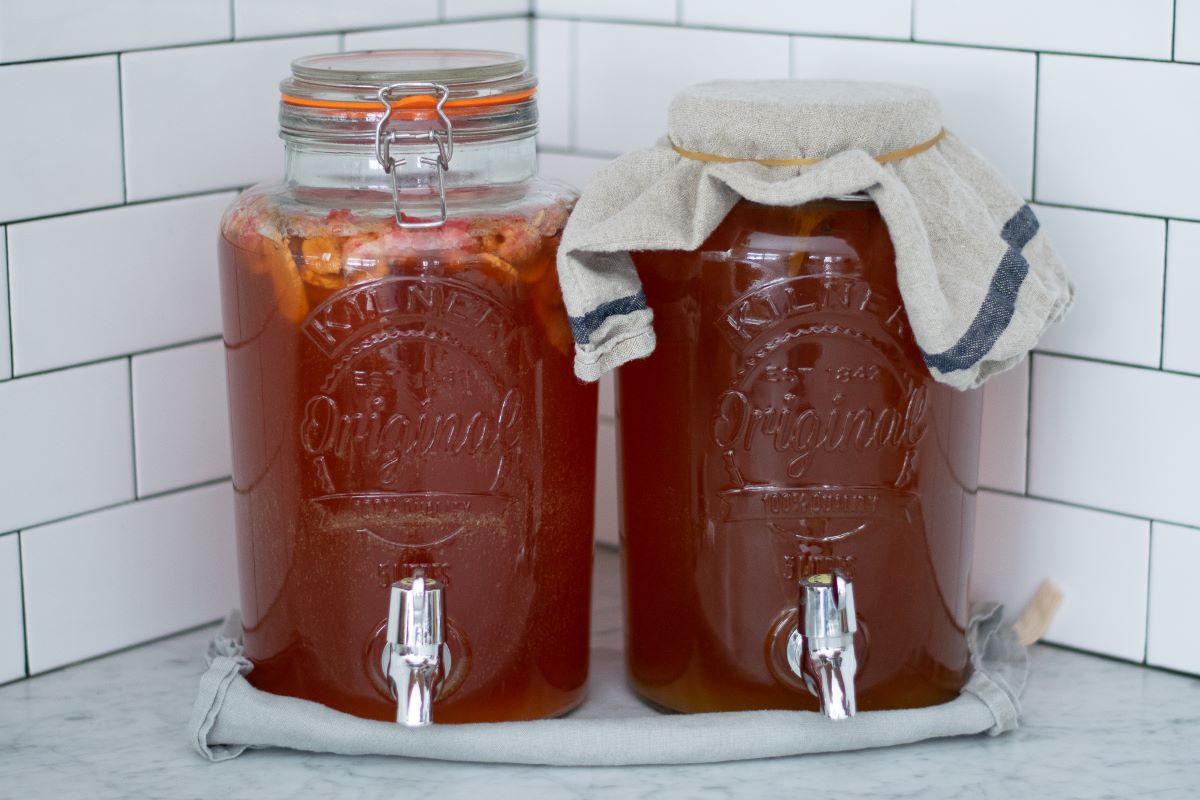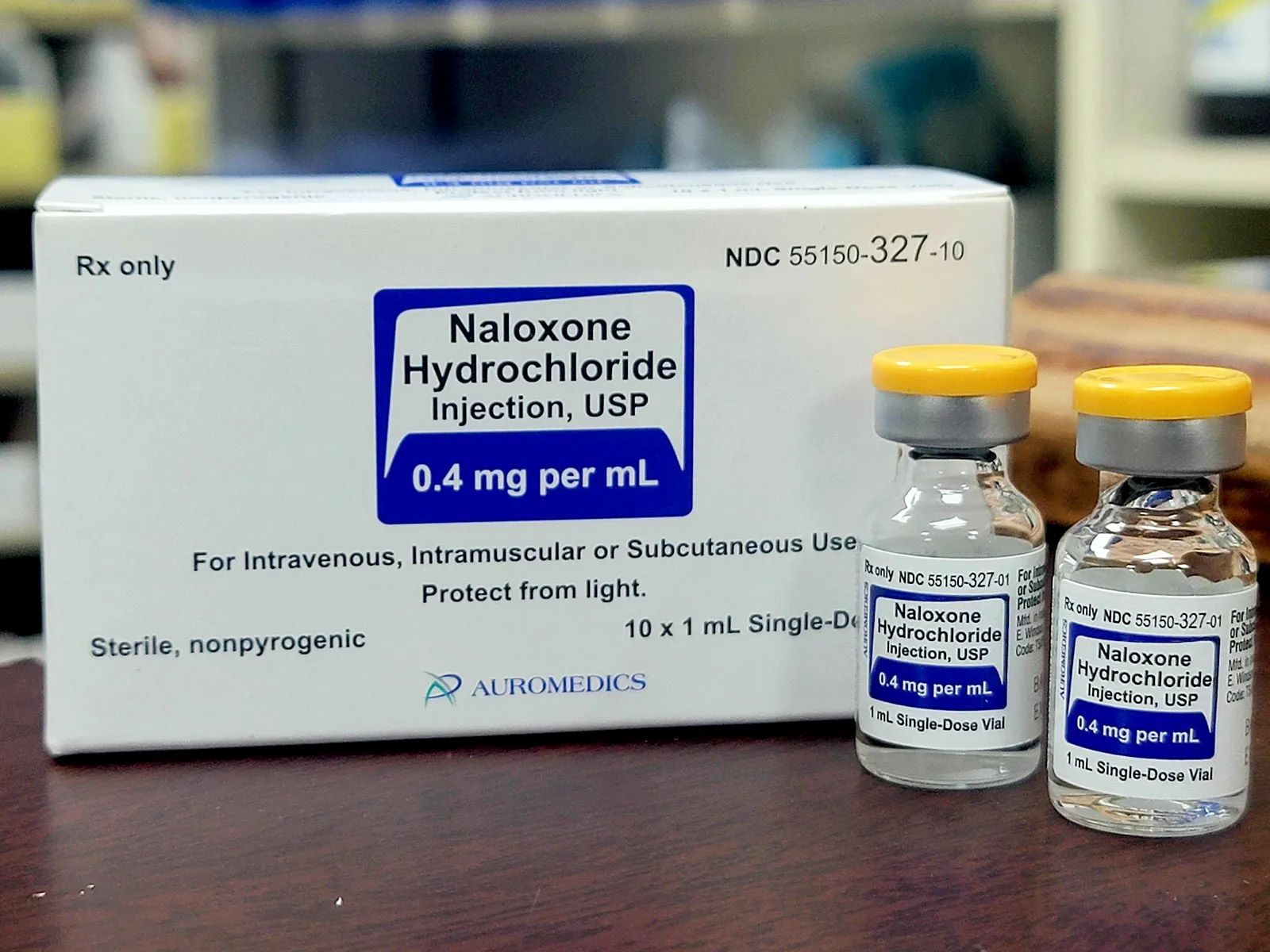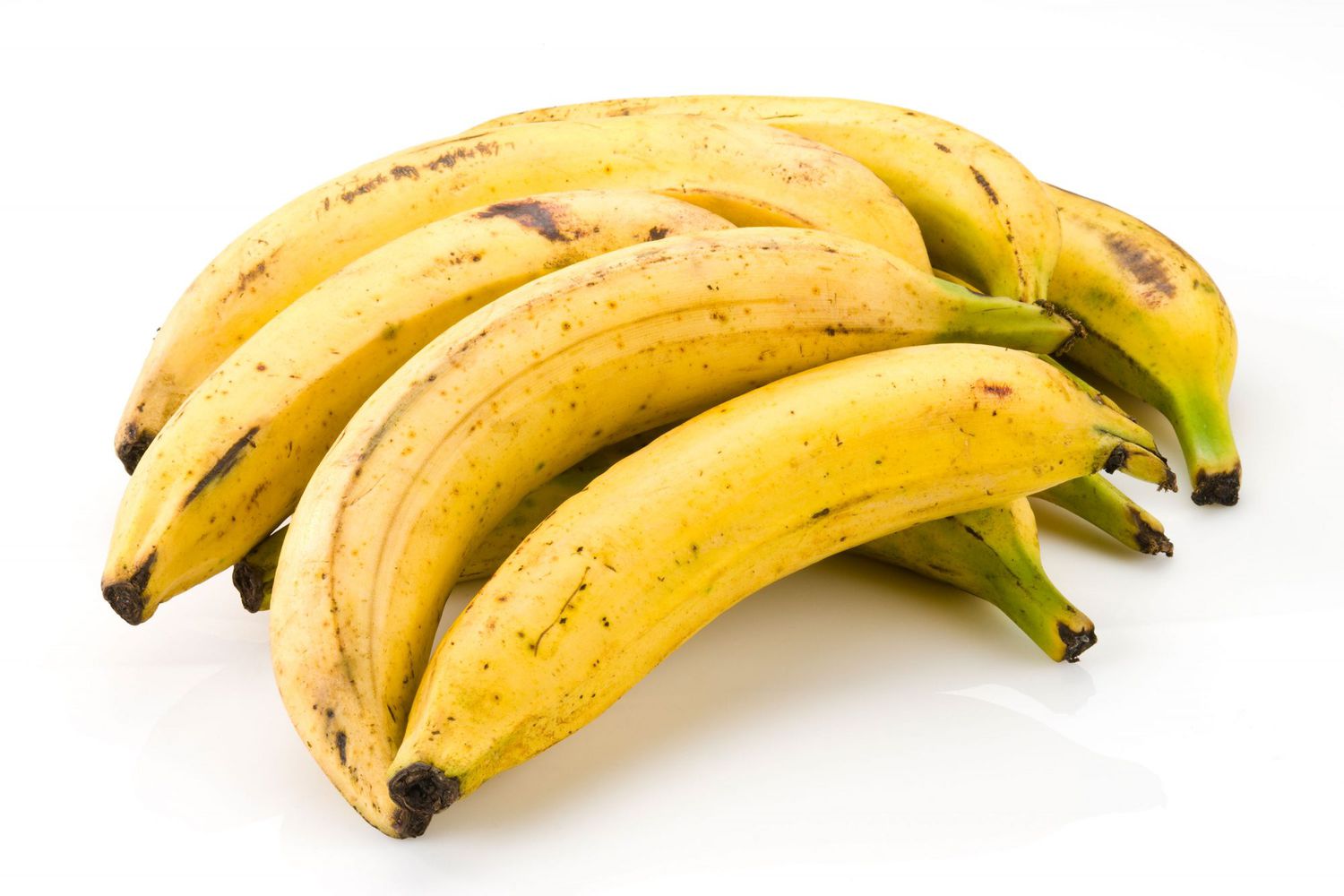

Articles
How To Store Kombucha
Modified: March 2, 2024
Discover expert tips and tricks on articles about how to store Kombucha properly, ensuring its taste and quality remain intact. Learn more now!
(Many of the links in this article redirect to a specific reviewed product. Your purchase of these products through affiliate links helps to generate commission for Storables.com, at no extra cost. Learn more)
Introduction
Welcome to the world of kombucha! If you are a fan of this delicious fermented beverage, you may be wondering how to properly store it to maintain its flavor and quality. Fret not, as we have got you covered! In this article, we will explore the ins and outs of kombucha storage and provide you with valuable tips to ensure your kombucha remains fresh and tasty.
For those who are new to the kombucha scene, let’s start with a brief introduction. Kombucha is a fizzy, tangy, and slightly sweet beverage made through the fermentation of tea and sugar by a symbiotic culture of bacteria and yeast, commonly known as SCOBY. This process results in a probiotic-rich drink with various potential health benefits.
Now that we have a good understanding of what kombucha is, let’s dive into the key factors to consider when it comes to storing this delightful drink.
Key Takeaways:
- Proper storage is crucial for maintaining the flavor, carbonation, and quality of kombucha. Factors such as temperature, light conditions, and container choices play a significant role in preserving this delightful beverage.
- Experimentation with long-term storage methods like secondary fermentation, cellaring, freezing, or dehydration can lead to unique flavor profiles. Trust your senses and enjoy the journey of preserving and savoring your kombucha.
Understanding Kombucha
Before we delve into the intricacies of storing kombucha, it’s essential to have a solid understanding of the factors that contribute to its overall quality and longevity.
Kombucha is a living beverage, thanks to the presence of active yeast and bacteria. These microorganisms continue the fermentation process even after the initial brewing is complete. As a result, kombucha can undergo further changes in flavor, carbonation, and acidity over time. While this ongoing fermentation can enhance the taste profile of the beverage, it also poses challenges when it comes to storage.
The acidity level of kombucha is crucial for its preservation and shelf life. The low pH of kombucha, usually around 3.0-3.5, helps inhibit the growth of harmful bacteria and molds. However, it’s essential to strike a balance because excessive acidity can lead to a sour taste and potential deterioration of the drink’s quality.
Another important aspect to consider is the carbonation level of kombucha. During the fermentation process, carbon dioxide is produced, resulting in the characteristic fizzy nature of the beverage. However, if kombucha is not stored properly, excessive carbonation can build up, leading to potential explosions or leakage.
Now that we have a basic understanding of kombucha and its peculiarities, let’s move on to the key factors you need to consider when storing your favorite fermented drink.
Factors to Consider for Storage
Proper storage is essential for maintaining the quality, flavor, and health benefits of your kombucha. Here are some key factors to consider:
Temperature:
The temperature at which you store your kombucha plays a significant role in its fermentation and overall shelf life. It is generally recommended to store kombucha between 68°F and 85°F (20°C and 29°C). This temperature range allows the fermentation process to continue at a steady pace without compromising the quality of the drink. Extreme temperature fluctuations can affect the taste and carbonation levels of the kombucha, so it’s important to keep it in a stable environment.
Light:
Exposure to direct sunlight or intense artificial light can negatively impact the quality of kombucha. Ultraviolet (UV) rays can degrade the flavor and also affect the beneficial bacteria present in the drink. It is recommended to store your kombucha in amber or dark glass bottles that offer some protection against light. Additionally, placing the bottles in a dark, cool cupboard or pantry will further shield them from light exposure.
Read more: How To Store Store-Bought Bread
Air Circulation:
Adequate air circulation is crucial for the proper fermentation of kombucha. While it’s important to protect the beverage from excessive airflow, completely sealing the container can lead to an anaerobic environment that might result in off-flavors or an increased risk of contamination. Choose a storage container with a breathable cover or lid that allows some airflow while keeping out contaminants.
Duration of Storage:
The duration for which you plan to store your kombucha will also determine the storage method you choose. If you plan to consume it within a few weeks, storing it at room temperature (68°F – 85°F or 20°C – 29°C) should suffice. However, if you wish to store it for an extended period, opting for refrigeration or other long-term storage methods will help maintain its quality for a longer time.
By considering these key factors, you can ensure that your kombucha remains flavorful and full of beneficial probiotics for a delightful drinking experience. In the next sections, we will explore specific storage containers and locations to further optimize the storage process.
Choosing the Right Container
When it comes to storing kombucha, choosing the right container is crucial to preserve its flavor, carbonation, and overall quality. Here are some container options to consider:
Glass Containers:
Glass containers are the preferred choice for storing kombucha due to their non-reactive nature. They don’t leach any harmful substances into the drink and are easy to clean and sanitize. Look for glass bottles or jars with airtight lids or swing-top closures to ensure a proper seal and prevent oxygen exposure. Additionally, opt for dark glass containers, such as amber or cobalt blue, as they offer UV protection by shielding the kombucha from light.
Read more: How To Store Basil From Grocery Store
Food-Grade Plastic Containers:
If glass containers are not practical for your storage needs, food-grade PET plastic containers can also be used. Ensure that the plastic used is specifically labeled as food-grade to avoid any potential contamination. Choose containers that are BPA-free and have airtight lids or screw caps to maintain a proper seal and prevent the entry of oxygen and contaminants.
Ceramic Containers:
Ceramic containers, such as crocks or fermentation jars, can also be suitable for storing kombucha. However, it’s important to ensure that the ceramic glaze used is food-safe and non-reactive. Some ceramic containers may have a porous surface, which can absorb flavors and potentially affect the taste of the kombucha. Make sure the container is thoroughly cleaned and sanitized before use.
Regardless of the container material you choose, make sure it has been properly cleaned and sanitized before storing your kombucha. Avoid using containers with residual flavors or odors, as these can transfer to the kombucha and affect its taste.
Remember, no matter the container you choose, it’s essential to maintain a proper seal to prevent oxygen exposure and maintain the carbonation levels of the kombucha. Store the containers upright to minimize the risk of leakage or excessive agitation during storage.
Now that we have discussed container options, let’s move on to selecting the appropriate location for storing your kombucha.
Selecting the Appropriate Location
Choosing the right location for storing your kombucha is essential to maintain its quality and prevent unwanted changes in taste, carbonation, and fermentation. Here are some factors to consider when selecting the appropriate location:
Away from Direct Sunlight:
One of the most critical considerations is to keep your kombucha away from direct sunlight. Exposure to UV rays can degrade the flavor and beneficial compounds in the drink. Look for a storage spot that is shielded from natural sunlight, such as a cupboard, pantry, or a dark corner of your kitchen. If you choose to store your kombucha on a countertop, ensure it is placed away from any windows or areas with direct sunlight.
Read more: How To Store Cinnabons
Stable Temperature:
Storing your kombucha in a location with a stable temperature is essential for maintaining its fermentation process and quality. Fluctuations in temperature can disrupt the microbial activity and affect the taste and carbonation levels of the drink. Aim for a consistent room temperature between 68°F and 85°F (20°C – 29°C) for optimal storage conditions.
Avoid Extreme Temperatures:
Avoid storing your kombucha in areas that are exposed to extreme temperatures, such as near stoves, ovens, radiators, or in cold drafty areas. Extreme heat or cold can negatively impact the fermentation process and alter the flavor and carbonation of the kombucha. Find a location that offers a moderate and consistent temperature, away from any temperature extremes.
Low Humidity:
Kombucha thrives in a moderately dry environment, so it’s important to avoid storing it in high humidity areas, such as near the dishwasher or in the bathroom. High humidity can promote the growth of mold and unwanted bacteria. Aim for a location that has moderate humidity levels, ideally between 55% and 75%, to prevent moisture-related issues.
Away from Strong Odors:
Kombucha has a unique flavor profile, and it can easily absorb strong odors from other foods or household products. Keep your kombucha away from strong-smelling substances such as onions, garlic, cleaning agents, or any other items that release potent odors. This will help preserve the authentic taste of the beverage.
By carefully selecting the appropriate location for storing your kombucha, you can ensure the retention of its flavor, carbonation, and overall quality. In the next sections, we will explore temperature and light conditions that are optimal for kombucha storage.
Read more: How To Store A Wreath
Temperature and Light Conditions
Proper temperature and light conditions are crucial for maintaining the quality and flavor of your kombucha. Let’s explore the ideal temperature range and the impact of light exposure on your kombucha storage:
Temperature:
Consistent temperature is key to preserving the fermentation process and the overall quality of kombucha. Aim to store your kombucha at a temperature between 68°F and 85°F (20°C – 29°C). This temperature range allows the beneficial bacteria and yeast to continue their fermentation at a steady pace, ensuring optimal flavor development and carbonation levels. Fluctuations in temperature can disrupt the fermentation process and result in inconsistent taste and quality.
Avoid storing your kombucha in areas that are exposed to extreme temperatures, such as near stoves, ovens, radiators, or in cold drafty areas. Extreme heat can lead to excessive fermentation, causing the drink to become overly acidic or develop off-flavors. Cold temperatures can slow down the fermentation process and may even cause complete cessation, halting the development of flavors and carbonation.
It’s important to note that the fermentation process continues even after bottling, albeit at a slower pace. Storing your kombucha at room temperature allows it to develop further and improve in flavor over time. However, if you wish to slow down the fermentation process, especially if your kombucha has reached the desired level of carbonation, you can choose to store it in the refrigerator.
Light Conditions:
Light exposure, particularly UV light, can have a detrimental effect on the flavor and quality of kombucha. UV rays can degrade the beneficial compounds in the beverage and also impact the flavor. It is highly recommended to store kombucha in a dark or opaque container, such as amber or cobalt blue glass bottles, to protect it from potential light damage.
In addition to storing the kombucha in dark bottles, it’s equally important to keep it in a dark location. Choose a storage spot away from direct sunlight or intense artificial light sources. Sunlight can prematurely age the kombucha, affecting its flavor and potentially causing off-flavors due to oxidation. Store your kombucha in a dark cupboard or pantry, or wrap the bottles in a cloth or place them in a box to shield them from light exposure.
By maintaining the proper temperature and protecting your kombucha from light exposure, you can ensure the preservation of its flavor, carbonation, and overall quality. In the next sections, we will explore specific storage methods, including refrigeration and long-term storage options.
Storing Kombucha in the Refrigerator
If you prefer a slower fermentation process and want to maintain the carbonation levels of your kombucha, storing it in the refrigerator is a great option. Refrigeration slows down the fermentation process and helps preserve the flavor and quality of the drink. Here are some tips for storing kombucha in the refrigerator:
Read more: How To Store Culantro
Choose the Right Temperature:
Set your refrigerator temperature between 35°F and 45°F (2°C to 7°C) to provide an optimal environment for storing kombucha. This temperature range slows down fermentation, allowing you to maintain the desired carbonation levels and flavor. Avoid storing kombucha in the freezer as this can halt fermentation and potentially damage the quality and texture of the drink.
Use Airtight Containers:
When storing kombucha in the refrigerator, it’s important to use airtight containers to prevent the loss of carbonation and the absorption of unwanted flavors or odors. Transfer your kombucha from the fermentation vessel to glass bottles with tight-fitting lids or swing-top closures. Make sure the bottles are clean and sanitized before use.
Avoid Frequent Movement:
Refrigerating kombucha requires minimal movement to ensure the preservation of carbonation. Every time you move or shake the bottles, you introduce agitation, which can result in excessive foaming and loss of carbonation. Try to handle the bottles gently and keep them in an upright position to minimize disturbance. This will help maintain the desired effervescence in your kombucha.
Consume Within a Reasonable Timeframe:
While refrigeration slows down fermentation, it does not completely halt it. Over time, the flavors and carbonation of kombucha will continue to evolve, albeit at a much slower rate. It is recommended to consume refrigerated kombucha within a few weeks to enjoy it at its best. As time passes, the flavors may become more pronounced, and the carbonation may gradually decrease.
Remember to store other food and beverages separately from your kombucha in the refrigerator, as strong odors can be absorbed by the drink and affect its taste profile.
Refrigeration is an excellent option for maintaining the quality of kombucha in the short term. However, if you plan to store your kombucha for an extended period, you may consider exploring long-term storage options, which we will discuss in the next section.
Read more: How To Store Tinctures
Long-Term Storage Options
If you’re looking to store your kombucha for an extended period, perhaps to age it or create unique flavor profiles, there are a few long-term storage options to consider. Here are some methods for preserving your kombucha over the long term:
Secondary Fermentation:
One method of long-term storage is through a process called secondary fermentation. After the initial brewing and primary fermentation, you can transfer the kombucha to bottles with airtight lids and continue the fermentation process at room temperature. This secondary fermentation allows the kombucha to develop additional carbonation and flavors over time. However, it’s essential to monitor the fermentation process closely to prevent over-fermentation and the risk of explosion. Burp the bottles regularly to release excess carbonation and maintain a safe pressure level.
Cellaring:
Cellaring involves storing kombucha in a cool and dark environment, typically in a basement or cellar. The temperature in these areas tends to be lower and more stable than the rest of the house. Optimal cellaring temperature for kombucha is around 55°F (13°C). Choose a location in your cellar or basement where the temperature remains consistent year-round, avoiding direct light exposure. Ensure that the bottles are properly sealed to prevent oxygen ingress and maintain carbonation. However, be aware that excessive aging can cause the flavors of the kombucha to change significantly.
Freezing:
Freezing kombucha can be an option for long-term storage, especially if you want to pause the fermentation process. Before freezing, make sure to transfer the kombucha to airtight containers, leaving some headspace for expansion. Be cautious with glass containers, as liquid expansion can cause breakage. Freezing suspends the fermentation process, preserving the kombucha’s flavor and carbonation, but it may slightly alter the texture. When you’re ready to consume the frozen kombucha, allow it to thaw slowly in the refrigerator and gently agitate the container to redistribute any settled solids.
Read more: How To Store Earrings
Dehydration and Powdering:
Another long-term storage option is to dehydrate your kombucha and make it into a powder. After the initial fermentation, you can spread the kombucha on a dehydrator sheet and dry it until it becomes crisp. Once dehydrated, you can grind it into a powder using a blender or food processor. The powdered kombucha can be stored in an airtight container in a cool, dark place for an extended period. When you’re ready to use it, simply rehydrate the powder in water or add it to recipes to infuse the kombucha flavor.
Keep in mind that long-term storage methods like secondary fermentation, cellaring, freezing, or dehydration may result in changes to the flavor, carbonation, and overall characteristics of the kombucha. Experimentation and careful monitoring are essential when exploring these storage options.
Now that we have explored various long-term storage options, let’s move on to some essential tips for maintaining the quality of your stored kombucha.
Tips for Maintaining Kombucha Quality
To ensure the quality and freshness of your stored kombucha, here are some important tips to follow:
1. Monitor Carbonation Levels:
Whether you store your kombucha at room temperature or in the refrigerator, it’s crucial to check the carbonation levels regularly. Excessive carbonation can lead to excessive pressure buildup, potential bottle explosions, or a foamy mess when opened. On the other hand, insufficient carbonation may result in a flat-tasting kombucha. Burp the bottles periodically to release excess carbonation and maintain the desired level of fizziness.
2. Keep Containers and Equipment Clean:
Maintaining clean containers and equipment is key to preventing contamination and preserving the quality of kombucha. Before storing kombucha, ensure that all containers, lids, funnels, and utensils are thoroughly cleaned and sanitized. Use hot water and mild soap or a food-grade sanitizer to eliminate any potential harmful microorganisms that could affect the taste and quality of the beverage.
Read more: How To Store Coquito
3. Rotate Your Stock:
If you have multiple batches of kombucha stored, it’s essential to rotate your stock to ensure you consume the oldest batches first. Over time, stored kombucha can start to lose some of its carbonation and fresh flavors, so it’s best to enjoy them while they are at their peak quality. Labeling your bottles with the brewing date can help you keep track of the order in which to consume your kombucha.
4. Store Unopened Bottles:
If you’re not planning to drink your kombucha immediately, it’s advisable to keep the bottles sealed and unopened until you’re ready to consume them. This helps to maintain carbonation and prevent oxygen exposure, which can lead to the degradation of flavor and quality. Once opened, consume the kombucha within a few days for the best taste experience.
5. Experiment with Flavors and Ingredients:
Stored kombucha can serve as a great base for experimenting with different flavors and ingredients. You can add fresh fruits, herbs, or spices to infuse new flavors into your kombucha. The longer you store your kombucha, the more pronounced these added flavors will become. Be creative and have fun exploring unique combinations to create your signature blends.
6. Trust Your Senses:
When it comes to consuming stored kombucha, trust your senses to determine its freshness. Give it a good sniff to ensure there are no off-putting or spoiled odors. Look for any signs of mold growth, unusual colors, or overly fizzy fermentation. If the kombucha smells or looks suspicious, it’s best to discard it to avoid any potential health risks.
Following these tips will help you maintain the quality, carbonation, and flavor of your stored kombucha, ensuring an enjoyable drinking experience. Now, let’s wrap up our article.
Read more: How To Store Gochugaru
Conclusion
Proper storage is essential for maintaining the flavor, carbonation, and quality of your beloved kombucha. By considering factors such as temperature, light conditions, and container choices, you can ensure that your kombucha remains fresh and delicious for an extended period.
Understanding the fermentation process and the unique characteristics of kombucha helps in making informed choices regarding its storage. Whether you opt for room temperature storage, refrigeration, or long-term storage methods such as secondary fermentation or cellaring, each method offers its own benefits and considerations.
Remember to choose the right container that is non-reactive and airtight to protect your kombucha from oxygen exposure and maintain its carbonation. Storing your kombucha in a dark location away from direct sunlight is essential for preventing UV damage and maintaining its flavor profile.
If you decide to store your kombucha in the refrigerator, ensure your fridge is set at an appropriate temperature to slow down fermentation without freezing the beverage. Regularly monitor carbonation levels and handle the bottles gently to avoid excessive agitation.
Long-term storage methods like secondary fermentation, cellaring, freezing, or dehydration offer ways to age or modify the flavor of your kombucha. However, be aware that these methods may bring about changes to its taste and characteristics, so experimentation and monitoring are key.
Additionally, by maintaining cleanliness, rotating your stock, and trusting your senses when consuming stored kombucha, you can ensure its optimal quality and safety.
So, whether you’re a kombucha enthusiast with a keen interest in aging your brew or simply looking to preserve the flavors of your favorite batch, following these tips will help you enjoy delicious, fizzy, and probiotic-rich kombucha for an extended period.
Remember, the storage process is part of the journey of enjoying your kombucha. So, have fun experimenting with flavors, monitoring its progress, and savoring the delightful results of your meticulously stored kombucha.
Frequently Asked Questions about How To Store Kombucha
Was this page helpful?
At Storables.com, we guarantee accurate and reliable information. Our content, validated by Expert Board Contributors, is crafted following stringent Editorial Policies. We're committed to providing you with well-researched, expert-backed insights for all your informational needs.







0 thoughts on “How To Store Kombucha”